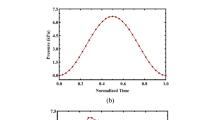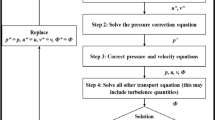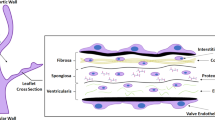Abstract
Aortic stenosis is the most common valvular heart disease. Assessing the contribution of the valve as a portion to total ventricular load is essential for the aging population. A CT scan for one patient was used to create one in vivo tricuspid aortic valve geometry and assessed with computational fluid dynamics (CFD). CFD simulated the pressure, velocity, and flow rate, which were used to assess the Gorlin formula and continuity equation, current clinical diagnostic standards. The results demonstrate an underestimation of the anatomic orifice area (AOA) by Gorlin formula and overestimation of AOA by the continuity equation, using peak velocities, as would be measured clinically by Doppler echocardiography. As a result, we suggest that the Gorlin formula is unable to achieve the intended estimation of AOA and largely underestimates AOA at the critical low-flow states present in heart failure. The disparity in the use of echocardiography with the continuity equation is due to the variation in velocity profile between the outflow tract and the valve orifice. Comparison of time-averaged orifice areas by Gorlin and continuity with instantaneous orifice areas by planimetry can mask the errors of these methods, which is a result of the assumption that the blood flow is inviscid.
Similar content being viewed by others
Abbreviations
- AOA:
-
Anatomic orifice area
- AS:
-
Aortic stenosis
- AV:
-
Aortic valve
- CAS:
-
Calcific aortic stenosis
- cath:
-
Cardiac catheterization
- CO:
-
Cardiac output
- dP:
-
Clinical pressure gradient
- C c :
-
Coefficient of contraction
- C v :
-
Coefficient of velocity
- CFD:
-
Computational fluid dynamics
- CT:
-
Computed tomography
- echo:
-
Echocardiography
- echo/cont.:
-
Echocardiography/continuity equation
- EOA:
-
Effective orifice area
- ECG:
-
Electrocardiogram
- Q :
-
Flow rate
- C :
-
Gorlin coefficient
- HR:
-
Heart rate
- LV:
-
Left ventricle
- LVOT:
-
Left ventricular outflow tract
- LVP:
-
Left ventricular pressure
- LVV:
-
Left ventricular volume
- MRI:
-
Magnetic resonance imaging
- P :
-
Pressure
- STJ:
-
Sino-tubular junction
- SEP:
-
Systolic ejection period
- TVI:
-
Time–velocity integral
- TAVI:
-
Transcatheter aortic valve implantation
- TEE:
-
Transesophageal echo
- TTE:
-
Transthoracic echo
- US:
-
Ultrasound
- V :
-
Velocity
- VC:
-
Vena contracta
References
Dill K.E., George E., Abbara S., Cummings K., Francois C.J., Gerhard-Herman M.D., Gornik H.L.: ACR appropriateness criteria imaging for transcatheter aortic valve replacement. J. Am. Coll. Radiol. 10(12), 957–965 (2013)
Gorlin R., Gorlin S.G.: Hydraulic formula for calculation of the area of the stenotic mitral valve, other cardiac valves, and central circulatory shunts. Am. Heart J. 41, 1–29 (1951)
Hatle L., Angelsen B.A., Tromsdal A.: Non-invasive assessment of aortic stenosis by Doppler ultrasound. Br. Heart J. 43, 284–292 (1980)
Loperfido F., Laurenzi F., Gimigliano F., Pennestri F., Biasucci L.M., Vigna C., De Santis F., Favuzzi A., Rossi E., Manzoli U.: A comparison of the assessment of mitral valve area by continuous wave doppler and by cross sectional echocardiography. Br. Heart J. 57, 348–355 (1987)
Otero H.J., Steigner M.L., Rybicki F.J.: The “Post-64” era of coronary CT angiography: understanding new technology from physical principles. Radiol. Clin. N. Am. 47, 79–90 (2009)
Seitz W.S., Furukawa K.: Hydraulic orifice formula for echographic measurement of the mitral valve area in stenosis: application to M-mode echocardiography and correlation with cardiac catheterisation. Br. Heart J. 46, 41–46 (1981)
Zoghbi W.A., Farmer K.L., Soto J.G., Nelson J.G., Quinones M.A.: Accurate non-invasive quantification of stenotic aortic valve area by doppler echocardiography. Circulation 73, 452–459 (1986)
Garcia, D., Kadem, L.: What do you mean by aortic valve area: geometric orifice area, effective orifice area, or gorlin area? J. Heart Valve Dis. 15(5), 601–608 (2006)
Dumesnil J.G., Yoganathan A.P.: Theoretical and practical differences between the Gorlin formula and the continuity equation for calculating aortic and mitral valve areas. Am. J. Cardiol. 67, 1268–1272 (1991)
Saikrishnan N., Kumar G., Sawaya F.J., Lerakis S., Yoganathan A.P.: Accurate assessment of aortic stenosis: a review of diagnostic modalities and hemodynamics. Circulation 129(2), 244–253 (2014)
Saikrishnan N., Yap C.H., Lerakis S., Kumar G., Yoganathan A.P.: Revisiting the Gorlin equation for aortic stenosis—is it correctly used in clinical practice?. Int. J. Cardiol. 168(3), 2881–2883 (2013)
Pasipoularides A., Murgo J.P., Miller J.W., Craig W.E.: Nonobstructive left ventricular ejection pressure gradients in man. Circul. Res. 61(2), 220–227 (1987)
Chambers J.B., Springings D.C., Cochrane T., Allen J., Morris R., Black M.M., Jackson G.: Continuity equation and Gorlin formula compared with directly observed orifice area in native and prosthetic aortic valves. Br. Heart J. 67, 193–199 (1992)
Kadem L., Rieu R., Dumesnil J.G., Durand L.-G., Pibarot P.: Flow-dependent changes in Doppler-derived aortic valve effective orifice area are real and not due to artifact. J. Am. Coll. Cardiol. 47(1), 131–137 (2006)
Utsunomiya H., Yamamoto H., Horiguchi J., Kunita E., Okada T., Yamazato R., Hidaka T., Kihara Y.: Underestimation of aortic valve area in calcified aortic valve disease: effects of left ventricular outflow tract ellipticity. Int. J. Cardiol. 157(3), 347–353 (2012)
Finegold J.A., Manisty C.H., Cecaro F., Sutaria N., Mayet J., Francis D.P.: Choosing between velocity–time-integral ratio and peak velocity ratio for calculation of the dimensionless index (or aortic valve area) in serial follow-up of aortic stenosis. Int. J. Cardiol. 167(4), 1524–1531 (2013)
Kumamaru K.K., Hoppel B.E., Mather R.T., Rybicki F.J.: CT angiography: current technology and clinical use. Radiol. Clin. N. Am. 48, 213–235 (2010)
Chow B.J.W., Kass M., Gagné O., Chen L., Yam Y., Dick A., Wells G.A.: Can differences in corrected coronary opacification measured with computed tomography predict resting coronary artery flow?. J. Am. Coll. Cardiol. 57, 1280–1288 (2011)
Koo B.-K., Erglis A., Doh J.-H., Daniels D.V., Jegere S., Kim H.-S., Dunning A., DeFrance T., Lansky A., Leipsic J., Min J.K.: Diagnosis of ischemia-causing coronary stenoses by noninvasive fractional flow reserve computed from coronary computed tomographic angiograms. J. Am. Coll. Cardiol. 58, 1989–1997 (2011)
Rybicki F.J.: Coronary flow dynamics measured by CT angiography. J. Am. Coll. Cardiol. 57, 1989–1990 (2011)
Steigner M.L., Mitsouras D., Whitmore A.G., Otero H.J., Wang C., Buckley O., Levit N.A., Hussain A.Z., Cai T., Mather R.T., Smedby O., DiCarli M.F., Rybicki F.J.: Iodinated contrast opacification gradients in normal coronary arteries imaged with prospectively ECG-gated single heart beat 320-detector row computed tomography. Circul. Cardiovasc. Imaging 3, 179–186 (2010)
Borkin M., Gajos K., Peters A., Mitsouras D., Melchionna S., Rybicki F.J., Feldman C., Pfister H.: Evaluation of artery visualizations for heart disease diagnosis. IEEE Trans. Vis. Comput. Graph. 17, 2479–2488 (2011)
Melchionna S., Bernaschi M., Succi S., Kaxiras E., Rybicki F.J., Mitsouras D., Coskun A.U., Feldman C.: Hydrokinetic approach to large-scale cardiovascular blood flow. Comput. Phys. Commun. 181, 462–472 (2010)
Rybicki F.J., Melchionna S., Mitsouras D., Coskun A.U., Whitmore A.G., Steigner M., Nallamshetty L., Welt F.G., Bernaschi M., Borkin M., Sircar J., Kaxiras E., Succi S., Stone P.H., Feldman C.L.: Prediction of coronary artery plaque progression and potential rupture from 320-detector row prospectively ECG-gated single heart beat CT angiography: lattice Boltzmann evaluation of endothelial shear stress. Int. J. Cardiovasc. Imaging 25, 289–299 (2009)
LaBounty T.M., Sundaram B., Agarwal P., Armstrong W.A., Kazerooni E.A., Yamada E.: Aortic valve area on 64-MDCT correlates with transesophageal echocardiography in aortic stenosis. Cardiopulm. Imaging 191, 1652–1658 (2008)
John A.S., Dill T., Brandt R.R., Rau M., Ricken W., Bachmann G., Hamm C.W.: Magnetic resonance to assess the aortic valve area in aortic stenosis: how does it compare to current diagnostic standards?. J. Am. Coll. Cardiol. 42, 519–526 (2003)
Abdulla J., Sivertsen J., Kofoed K.F., Alkadhi H., LaBounty T., Abildstrom S.Z., Kober L., Christensen E., Torp-Pedersen C.: Evaluation of aortic valve stenosis by cardiac multi-slice computed tomography compared with echocardiography: a systematic review and meta-analysis. J. Heart Valve Dis. 18, 634–643 (2009)
LaBounty T., Agarwal P.P., Chughtai A., Kazerooni E.A., Wizauer E., Bach D.S.: Hemodynamic and functional assessment of mechanical aortic valves using combined echocardiography and multidetector computed tomography. J. Card. Comput. Tomogr. 3, 161–167 (2009)
Leuprecht A., Perktold K., Kozerke S., Boesiger P.: Combined CFD and MRI study of blood flow in human ascending aorta model. Biorheology 39, 425–429 (2002)
Badano L., Cassottana P., Bertoli D., Carratino L., Lucatti A., Spirito P.: Changes in effective aortic valve area during ejection in adults with aortic stenosis. Am. J. Cardiol. 78, 1023–1028 (1996)
Ropers D., Ropers U., Marwan M., Schepis T., Pfederer T., Wechsel M., Klinghammer L., Flachskampf F.A., Daniel W.G., Achenbach S.: Comparison of dual-source computed tomography for the quantification of the aortic valve area in patients with aortic stenosis versus transthoracic echocardiography and invasive hemodynamic assessment. Am. J. Cardiol. 104, 1561–1567 (2009)
Koch T.M., Reddy B.D., Zilla P., Franz T.: Aortic valve leaflet mechanical properties facilitate. Comput. Methods Biomech. Biomed. Eng. 13(2), 225–234 (2010)
Auricchio F., Conti M., Demertzis S., Morganti S.: Finite element analysis of aortic root dilation: a new procedure to reproduce pathology based on experimental data. Comput. Methods Biomech. Biomed. Eng. 14(10), 875–882 (2011)
Khalife M., Rodriguez D., de Rochefort L., Durand E.: In vitro validation of non-invasive aortic compliance measurements using MRI. Comput. Methods Biomech. Biomed. Eng. 15(Suppl 1), 83–84 (2012)
Chnafa C., Mendez S., Nicoud F., Moreno R., Nottin S., Schuster I.: Image-based patient-specific simulation: a computational modelling of the human left heart haemodynamics. Comput. Methods Biomech. Biomed. Eng. 15(Suppl 1), 74–75 (2012)
Moosavia M.-H., Fatouraeea N., Katoozianb H., Pashaeic A., Camarad O., Frangie A.F.: Numerical simulation of blood flow in the left ventricle and aortic sinus using magnetic resonance imaging and computational fluid dynamics. Comput. Methods Biomech. Biomed. Eng. 17(7), 1–10 (2012)
Krittian S., Schenkel T., Janoske U., Oertel H.: Partitioned fluid–solid coupling for cardiovascular blood flow: validation study of pressure-driven fluid–domain deformation. Ann. Biomed. Eng. 38(8), 2676–2689 (2010)
Auricchio, F., Conti, M., Ferrara, A., Morganti, S., Reali, A.: Patient-specific simulation of a stentless aortic valve implant: the impact of fibres on leaflet performance. Comput. Methods Biomech. Biomed. Eng. 17(3), 277–285 (2014)
Auricchio F., Conti M., Morganti S., Reali A.: Simulation of transcatheter aortic valve implantation: a patient-specific finite element approach. Comput. Methods Biomech. Biomed. Eng. 17(3), 1–11 (2013)
Agarwal, R.K., Rifkin, R., Okpara, E., Foote, T., Daiber, J.: Numerical study of pulsatile flow through models of vascular and aortic valve stenoses and assessment of gorlin equation. In: 40th Fluid Dynamics Conference and Exhibit, June 28–July 1, 2010, Chicago, IL, American Institute of Aeronautics and Astronautics, pp. 2010–4733
Garcia D., Pibarot P., Landry C., Allard A., Chayer B., Dumesnil J.G., Durand L.-G.: Estimation of aortic valve effective orifice area by doppler echocardiography: effects of valve inflow shape and flow rate. J. Am. Soc. Echocardiogr. 17(7), 756–765 (2004)
Baumgartner H., Khan S., DeRobertis M., Czer L., Maurer G.: Effect of prosthetic aortic valve design on the Doppler–Catheter gradient correlation: an in vitro study of Normal St, Jude, Medtronic-Hall, Starr-Edwards and Hancock Valves. J. Am. Coll. Cardiol. 19(2), 324–332 (1992)
Bongert, M., Geller, M., Pennekamp, W., Roggenland D., Nicolas, V.: Transient simulation of the blood flow in the thoracic aorta based on MRI-data by fluid–structure-interaction. In: 4th European Conference of the International Federation for Medical and Biological Engineering, Volume 22 of the series IFMBE Proceedings, pp. 2614–2618 (2008)
DeGroff C.G., Shandas R., Valdes-Cruz L.: Analysis of the effect of flow rate on the Doppler continuity equation for stenotic orifice area calculations: a numerical study. Circulation 97(16), 1597–1605 (1998)
Chandra S., Rajamannan N.M., Sucosky P.: Computational assessment of bicuspid aortic valve wall–shear stress: implications for calcific aortic valve disease. Biomech. Model. Mechanobiol. 11(7), 1085–1096 (2012)
Deen W.M.: Analysis of Transport Phenomena. Oxford University Press, New York (1998)
Marcinkowska-Gapinska A., Gapinski J., Elikowski W., Jaroszyk F., Kubisz L.: Comparison of three rheological models of shear flow behavior studied on blood samples from post-infarction patients. Med. Biol. Eng. Comput. 45((9), 837–844 (2007)
Eckmann D.M., Bowers S., Stecker M., Cheung A.T.: Hematocrit, volume expander, temperature, and shear rate effects on blood viscosity. Anesth. Analg. 91(3), 539–545 (2000)
Pries A.R., Neuhaus D., Gaehtgens P.: Blood viscosity in tube flow: dependence on diameter and hematocrit. Am. J. Physiol.-Heart Circul. Physiol. 263(6), H1770–H1778 (1992)
Dille J., De Vleeschouwer M., Boelen E.: The usage of medical images for creating custom FE and CFD models. Adv. Prod. Eng. Manag. 5(2), 117–120 (2010)
Cebral J.R., Mut F., Sforza D., Lohner R., Scrivano E., Lylyk P., Putman C.: Clinical application of image-based CFD for cerebral aneurysms. Int. J. Numer. Methods Biomed. Eng. 27(7), 977–992 (2011)
Briand M., Dumesnil J.G., Kadem L., Tongue A.G., Rieu R., Garcia D., Pibarot P.: Reduced systemic arterial compliance impacts significantly on left ventricular afterload and function in aortic stenosis: implications for diagnosis and treatment. J. Am. Coll. Cardiol. 46(2), 291–298 (2005)
Garcia D., Barenbrug P.J.C., Pibarot P., Dekker A.L.A.J., van der Veen F.H., Maessen J.G., Dumesnil J.G., Durand L.-G.: A ventricular–vascular coupling model in presence of aortic stenosis. Am. J. Physiol.-Heart Circul. Physiol. 288(4), H1874–H1884 (2005)
Westerhof N., Boer C., Lamberts R.R., Sipkema P.: Cross-talk between cardiac muscle and coronary vasculature. Physiol. Rev. 86(4), 1263–1308 (2006)
Gilon D., Cape E.G., Handschumacher M.D., Song J.-K., Solheim J., VanAuker M., King M.E.E., Levine R.A.: Effect of three-dimensional valve shape on the hemodynamics of aortic stenosis: three-dimensional echocardiographic stereolithography and patient studies. J. Am. Coll. Cardiol. 40(8), 1479–1486 (2002)
Bahlmann E., Cramariuc D., Gerdts E., Gohlke-Baerwolf C., Nienaber C.A., Eriksen E., Wachtell K., Chambers J., Kuck K.H., Ray S.: Impact of pressure recovery on echocardiographic assessment of asymptomatic aortic stenosis: a SEAS substudy. JACC: Cardiovasc. Imaging 3(6), 555–562 (2010)
Baumgartner H.: Hemodynamic assessment of aortic stenosis: are there still lessons to learn?. J. Am. Coll. Cardiol. 47(1), 138–140 (2006)
Garcia D., Dumesnil J.G., Durand L.-G., Kadem L., Pibarot P.: Discrepancies between Catheter and Doppler estimates of valve effective orifice area can be predicted from the pressure recovery phenomenon: practical implications with regard to quantification of aortic stenosis severity. J. Am. Coll. Cardiol. 41(3), 435–442 (2003)
Garcia D., Pibarot P., Durand L.-G.: Analytical modeling of the instantaneous pressure gradient across the aortic valve. J. Biomech. 38(6), 1303–1311 (2005)
Baumgartner H.: Aortic stenosis severity: do we need a new concept?. J. Am. Coll. Cardiol. 54(11), 1012–1013 (2009)
Baumgartner H., Schima H., Tulzer G., Kuhn P.: Effect of stenosis geometry on the Doppler–Catheter gradient relation in vitro: a manifestation of pressure recovery. J. Am. Coll. Cardiol. 21(4), 1018–1025 (1993)
Baumgartner H., Stefenelli T., Niederberger J., Schima H., Maurer G.: “Overestimation” of Catheter gradients by doppler ultrasound in patients with aortic stenosis: a predictable manifestation of pressure recovery. J. Am. Coll. Cardiol. 33(6), 1656–1661 (1999)
Yoganathan A.P., Cape E.G., Sung H.-W., Williams F.P., Jimoh A.: Review of hydrodynamic principles for the cardiologist: applications to the study of blood flow and jets by imaging techniques. J. Am. Coll. Cardiol. 12(5), 1344–1353 (1988)
Garcia D., Camici P.G., Durand L.-G., Rajappan K., Gaillard E., Rimoldi O.E., Pibarot P.: Impairment of coronary flow reserve in aortic stenosis. J. Appl. Physiol. 106(1), 113–121 (2009)
Garcia D., Pibarot P., Dumesnil J.G., Sakr F., Durand L.-G.: Assessment of aortic valve stenosis severity: a new index based on the energy loss concept. Circulation 101(7), 765–771 (2000)
Evin M., Guivier-Curien C., Tanne D., Pibarot P., Rieu R.: Geometrical orifice area compared to effective orifice area of valvular mitral bioprosthesis: in vitro study. Comput. Methods Biomech. Biomed. Eng. 15(sup1), 53–55 (2012)
Otto C.M., Pearlman A.S., Comess K.A., Reamer R.P., Janko C.L., Huntsman L.L.: Determination of the stenotic aortic valve area in adults using doppler echocardiography. J. Am. Coll. Cardiol. 7(3), 509–517 (1986)
Frydrychowicz A., Weigang E., Langer M., Markl M.: Flow-sensitive 3D magnetic resonance imaging reveals complex blood flow alterations in aortic dacron graft repair. Interact. Cardiovasc. Thorac. Surg. 5, 340–342 (2006)
Rybicki F.J., Otero H.J., Steigner M.L., Vorobiof G., Nallamshetty L., Mitsouras D., Ersoy H., Mather R.T., Judy P.F., Cai T., Coyner K., Schultz K., Whitmore A.G., Di Carli M.F.: Initial evaluation of coronary images from 320-detector row computed tomography. Int. J. Cardiovasc. Imaging 24(5), 535–546 (2008)
Hsiao E.M., Rybicki F.J., Steigner M.: CT coronary angiography: 256-slice and 320-detector row scanners. Curr. Cardiol. Rep. 12(1), 68–75 (2010)
Leipsic J., LaBounty T.M., Heilbron B., Min J.K., Mancini G.B.J., Lin F.Y., Taylor C., Dunning A., Earls J.P.: Estimated radiation dose reduction using adaptive statistical iterative reconstruction in coronary CT angiography: the ERASIR study. Am. J. Roentgenol. 195(3), 655–660 (2010)
Hachicha Z., Dumesnil J.G., Pibarot P.: Usefulness of the valvuloarterial impedance to predict adverse outcome in asymptomatic aortic stenosis. J. Am. Coll. Cardiol. 54(11), 1003–1011 (2009)
Pibarot P., Dumesnil J.G.: Aortic stenosis: look globally, think globally. J. Am. Coll. Cardiol. Imaging 2(4), 400–403 (2009)
Author information
Authors and Affiliations
Corresponding author
Additional information
Communicated by Jeff D. Eldredge.
Rights and permissions
About this article
Cite this article
Traeger, B., Srivatsa, S.S., Beussman, K.M. et al. Methodological inaccuracies in clinical aortic valve severity assessment: insights from computational fluid dynamic modeling of CT-derived aortic valve anatomy. Theor. Comput. Fluid Dyn. 30, 107–128 (2016). https://doi.org/10.1007/s00162-015-0370-9
Received:
Accepted:
Published:
Issue Date:
DOI: https://doi.org/10.1007/s00162-015-0370-9




